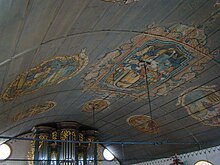Church of the Holy Cross (hamlet on the Zaber)
The Church of the Holy Cross in Weiler an der Zaber , a district of Pfaffenhofen in the Heilbronn district in northern Baden-Württemberg , is a Protestant parish church . The tower of the church dates back to the high Middle Ages, the nave was renovated and painted in the 18th century.
history
The origins of the church in Weiler are in the dark. Around 1300 it existed as a fortified church . The oldest part of the church, the substructure of the tower, which has a ribbed vault with early and late Gothic paintings, dates from that time .
In the time before the Peasants' War , Anton Eisenhut was an episcopal Speyer priest in Weiler. Eisenhut became a peasant leader and was beheaded in Bruchsal in 1525. During the Thirty Years War , Weiler was almost depopulated. The church survived the war, but the means to continue to support it were lacking afterwards. In 1698 the building was dilapidated, in 1701 the spire burned down after a lightning strike. For many years it was only temporary repairs.
In 1751 the church was extensively renovated. The medieval tower choir was walled up and new pews in the church in the style of a transverse church were aligned with the pulpit in the middle of the southern long side. The nave also received a new wooden three-sided gallery as well as the parsonage or lattice stalls for the pastor's family, as the remaining seats had been sold to the parishioners. The men had their seats in the galleries, the women had women's chairs downstairs , the youth stood in front of the pulpit.
In 1767 the church was painted by Johannes Stiegler from Prague. The sayings around the pictures were probably composed by the pastor Johann Eberhard Gottlob Schober (1722–1768).
It is no longer known today when the church organ was procured. It is an instrument built by Friedrich Philipp Wiegleb in Bönnigheim around 1730, which has been in the church since the early 19th century at the latest. Only the organ prospectus is still old, because the organ was renovated several times and in 1994 it was finally given a new organ made by Mühleisen in Leonberg.
The last renovation in the church took place in 1984.
Painting
The circumstances of the painting of the church are documented in the protocol of the church convention and on a board in the church. On April 20, 1767, the minutes recorded ongoing negotiations with the Prague painter Johannes Stiegler , who also painted various other churches in the Württemberg lowlands . An agreement was reached on April 29, 1727, and Stiegler was commissioned. He received free board and lodging for the duration of the work and 50 guilders at the end of the work. The parishioners bore the costs. The painting was done in a little over two months. The main parapets, the pulpit and the wooden barrel vault of the church were painted. The paintings show various biblical scenes. The sayings accompanying the paintings presumably come from the local pastor at the time.
The pulpit is decorated with scenes of the beheading of John the Baptist (“A teacher must tell the truth and one should cut off his head”), a Pentecost depiction (“The Holy Spirit first makes skillful and then makes the congregation happy”) and a scene Jesus, who puts a host in the mouth of believers ("Lord Jesus, put the word in my mouth that I speak edifyingly every hour"), decorated.
The organ gallery shows scenes from the Old Testament, including Adam and Eve in Paradise, the Fall, Cain and Abel, the Flood, Adam's sacrifice with Isaac and the Exodus from Egypt. It is striking that many of the Old Testament scenes refer to the New Testament salvation history in their sayings. Adam's sacrifice with Isaac is labeled with "Isaac must not die for us, Jesus wants to acquire salvation", elsewhere we find "If Adam already introduces sin, Jesus wants to be the Savior". The depiction of the three men in the fiery furnace is subtitled with "It's better to die in the fire than to spoil through picture service", which is understood as a clear swipe at Catholic services with their veneration of saints.
New Testament scenes are shown on a total of 18 pictures in the western area of the three-sided gallery, including common motifs such as the circumcision of Christ, the 12-year-old Jesus in the temple, crucifixion and burial, but also rarely shown motifs such as a scene from Matthew 17 in who Jesus and his disciples find the penny needed for the temple tax in the mouth of a fish.
The wooden barrel vault of the church mainly shows motifs on the themes of penance and conversion with a large depiction of the Lord's Supper as the central motif. The coat of arms of the then Duke of Württemberg, Carl Eugen, is also on the ceiling . In addition, Stiegler created a large panel with the Last Judgment, which was hung above the western gallery. On the western gable wall there is an inscription plaque naming the painter, the pastor at the time, the mayor and some men of honor.
The type and execution of the paintings is much simpler than in many other churches that were painted in the Baroque style at the same time . Nevertheless, one can see in these paintings, which were created in a short time, an important testimony to rural Protestant piety in the 18th century, which make the church in Weiler a cultural monument .
literature
- Hermann Aichele-Tesch: Church of the Holy Cross in Weiler an der Zaber . Evang. Parish, Weiler an der Zaber 1997
Web links
Coordinates: 49 ° 3 ′ 26.8 ″ N , 8 ° 57 ′ 3 ″ E







